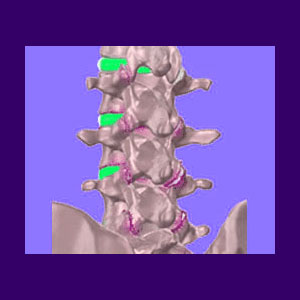
A sacralized vertebra is a type of natural spinal fusion which typically occurs at L5. In some cases, a transitional vertebra can exist, (named L6) and this can also be sacralized in rare instances. In extreme cases, 2 vertebrae may be sacralized, usually L5 and L4.
While sacralization can be diagnosed via x-ray or MRI scans as a spinal abnormality, there is no indication that it is responsible for enacting pain or neurological symptoms in the vast majority of affected patients.
This dialog examines the incidence of sacralization in the lumbar spine, as well as its potential effects on the overall form and function of the vertebral column.
Sacralized Vertebra Back Pain
Sacralized L5 can possibly cause pain through several possible modalities:
Improper bone alignment in the fusion can result in central spinal stenosis or foraminal stenosis. In most cases, these will not be symptomatic, but in serious examples, pain and nerve effects may result.
Facet joint syndrome may result in the area, although these structural changes are normal in most patients and are not likely to be the source of pain, since the fused vertebrae do not move against one another.
A partial sacralization may indicate some degree of movement, with bone on bone contact being possible. This is one of the most logical reasons for low back pain to exist and is generally treated surgically with reinforcing hardware to form a tight spinal fusion.
Sacralized Spinal Bones Information
Many back doctors and chiropractors used to blame this anatomical irregularity for causing lower back pain and sciatica in almost every patient. Times have changed and now doctors realize that this condition is almost always benign and non-problematic.
In a few cases, there are verifiable reasons why the sacralized spinal bones are indeed painful and these can usually be fixed using minimally invasive back surgery techniques. In some circumstances, full spinal fusions will have to be performed to further fuse the region and stabilize the spine. Luckily, this is rarely a needed procedure, since it is horrific to endure and sometimes makes the painful complaint far worse and impossibly chronic.
Sacralized Vertebra Analysis
In most of the cases that we see where patients have been told that their pain is a direct result of a sacralization scenario, there is absolutely no evidence of a pathological process to support the theory. The central and foraminal spaces are preserved and the alignment of the bones seems normal, despite the fusion. These cases also rarely respond well to treatment, which is why so many patients are looking for advice to begin with.
If your symptoms have been blamed on a sacralization condition at the lumbosacral juncture, it is definitely worth investigating the matter further. We always recommend seeking a few opinions from several different types of doctors, including an orthopedist and a neurologist. Additionally, we recommend you ask each doctor how pain is being produced, if indeed they feel the condition is a cause or contributor.
The more you know and the better you understand the diagnosis, the less likely you will be to suffer ineffective and unneeded treatment for a spinal abnormality which might just be completely innocent of all blame.





